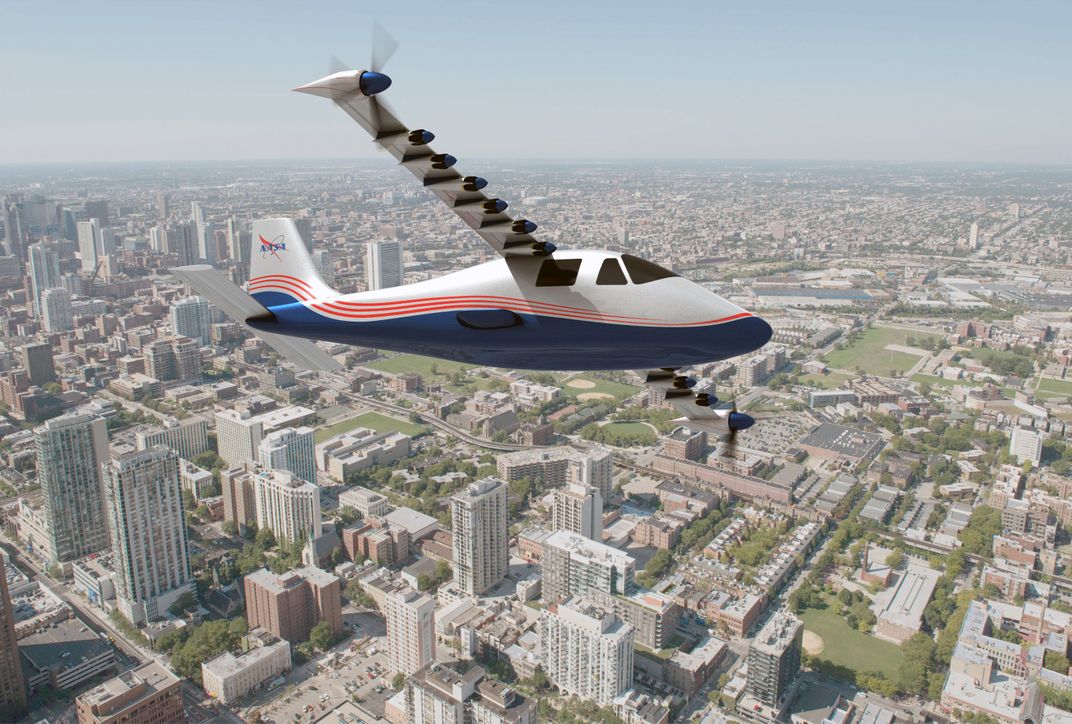NASA Wants Ideas for the Next Electric Airplane
Looking beyond the X-57.
:focal(472x287:473x288)/https://tf-cmsv2-smithsonianmag-media.s3.amazonaws.com/filer/dd/29/dd29c198-f5ec-41d5-9d21-1ea30435b8da/df-depxq_2_nasanew.jpg)
NASA is leading the charge toward the next step in electrically powered aviation. Even as the X-57 Maxwell—a demonstrator of distributed electric propulsion and the agency’s first crewed X-plane in decades—is being assembled, the agency has released a Request for Information (RFI) to solicit ideas for a follow-on.
The new RFI, released on September 16, calls for electric or electric-hybrid concepts in one (or more) of four categories: a conventional airplane capable of carrying four to nine people; a vertical-takeoff-and-landing (VTOL) airplane for at least one person; a regional jet-sized airplane capable of operating in airspace under current regulations; and a catch-all that essentially means “good ideas that don’t fit in the previous bins.” Tantalizingly, the RFI specifically suggests that the first three objectives could be used to address a production aircraft.
It’s just an RFI, meant to give NASA an idea of what aerospace engineers think is possible rather than to elicit detailed designs, but it telegraphs just how seriously NASA takes electric aircraft. Far from being an only child, the X-57 will be the first in a family of designs, meant to bring electric or hybrid-electric power to ever-larger aircraft.
“This request is about feeling out how much larger people think they can go,” says Starr Ginn, Deputy Aeronautics Research Director at NASA’s Armstrong flight test center. “And is that next-scale vehicle something they could possibly spin off into the commercial market right away, or is it a way to buy down risk for much larger aircraft?”
In the best tradition of X-planes, the RFI seeks concepts that are ambitious but still within the realm of practicality. Despite several flying prototypes and one-offs, the industry has been hesitant to embrace electric and hybrid-electric aircraft. The biggest reason is fairly straightforward: fossil fuels are incredibly convenient, while even the best batteries impose serious flight restrictions. The RFI requests concepts for aircraft weighing at least 5,000 pounds at takeoff (1,000 for the VTOL option), capable of reaching at least 150 knots and staying airborne for an hour. That pushes the state of the art for batteries, but there are many, many conventional-fueled aircraft that can meet those specifications without any trouble. (For reference, the bog-standard Beech Baron weighs about 5,100 pounds, boasts a 200-knot cruise speed and four-hour endurance).
“We’re not going to jump right from a two-passenger airplane to a 100-passenger airplane. Just like in the days of old, advancing from piston engines to jet engines, it took about 40 years to go from a single-pilot airplane (the Wright Brothers) to a 100-person airplane,” says Ginn. “These days I think we can move faster, but we’ve got to take incremental steps that technologies can keep up with.”

Whether or not this RFI results in a flying X-plane is still unknown. After decades of relative obscurity, NASA’s aeronautics division got a big boost in the last White House budget request—an increase of nearly $4 billion over ten years. The upcoming X-57 tests are one result of the increase, and NASA is enthusiastically working out the details of three other X-planes that the agency hopes to fly in the near future. But with the presidential election in full swing (though both candidates have space policies, neither has weighed in on aeronautics) and Congressional dysfunction ongoing, it’s an open question as to whether that increased budget request will translate into real funding. But if it does, says Ginn, NASA wants to be ready to hit the ground running.
Though most electric aircraft prototypes and concepts are designed for use by the same people who fly conventional airplanes, they are sufficiently different that they could cleave one market into two. For example, flight schools are often considered prime markets for electric aircraft, which could potentially cut their operating costs by 80 percent—electric motors are much simpler than their fuel-burning counterparts, and electricity from the grid is far cheaper than gasoline—but they’d have to weigh that against the drawbacks of shorter flights and lengthy battery recharge times. An electric four-to-nine-seater could potentially bring profit back to an all-but-moribund segment of commercial aviation. There could even be as-yet unenvisioned markets: electric propulsion completely removes some of the biggest traditional design constraints, things like fuel tanks, air cooling, even limits to the number of engines. So who knows what comes next?
“I am expecting there are going to be some very intriguing configurations that people haven’t thought of yet,” says Ginn. “The degrees of freedom opened up to design airplanes are so vast now, every designer I talk to about this area is like a kid in a candy store. There are so many things to explore they don’t even know where to start.”